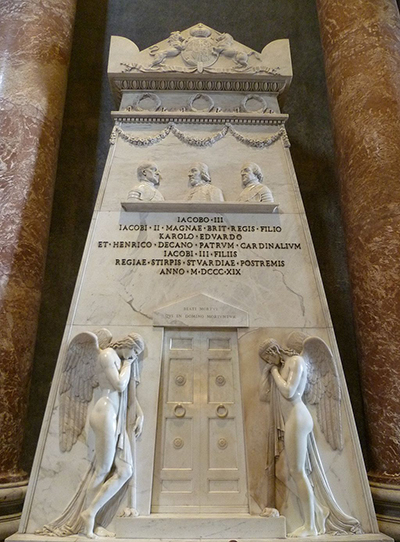Of all the impressive sculptures to be found within the St. Peter's Basilica in Vatican City, there is an important one from the career of Antonio Canova which is worth further investigation. It is the Monument to the Royal Stuarts, which connects directly with the three kings of England, Scotland and Ireland.
It is rare for Canova to have worked on something with a strong connection to British history, with most of his work concerned with Italian history or ancient literature. As his reputation grew he was able to build a strong base of support with a number of prominent patrons helping him to draw in all manner of different commissions. His strong studio would assist him in completing this large body of work and so he continued to ambitiously desire as many of the most prominent projects as possible. Canova would take on several tombs, for example, though this particular item in front of us here is not serving that role. It is more of an acknowledge of their presence within the Basilica, rather than attempting to host them itself. The tomb designs would have separate sculptures positioned within an overall composition, where as this monument is a relief, where the objects are "raised" from the main body of stone. We find the three princes near to the top of the structure, with two comtemplative figures further below, either side of a closed door. The area in between the two rows of figures carries an inscription as follows:
IACOBO·III
IACOBI·II·MAGNAE·BRIT·REGIS·FILIO
KAROLO·EDVARDO
ET·HENRICO·DECANO·PATRUM·CARDINALIVM
IACOBI·III·FILIIS
REGIAE·STIRPIS·STVARDIAE·POSTREMIS
ANNO·M·DCCC·XIX
The above text translates as, "To James III, son of King James II of Great Britain, to Charles Edward and to Henry, Dean of the Cardinal Fathers, sons of James III, the last of the Royal House of Stuart. 1819." The status of the Stuarts who have been exiled is the reason for why the figures below them weep in sadness. The work for this whole project was commissioned by Monsignor Angelo Cesarini who used funds from the death of Henry Benedict Stuart whilst organising his will. Several British figures agreed to the idea, perhaps surprisingly in the example of King George IV who had not always served as a ally. The overall monument remains popular with those who follow that period of British history, sometimes adorning the monument with gifts as a way of showing respect to these three figures. James Francis Edward Stuart was buried in the Basilica in 1766, whilst Charles Edward Stuart and Henry Benedict Stuart passed away in the decades that followed on afterwards. There would also be tombstones added to their actual burial sites as a further mark of their final resting places.
It is examples such as this which show how Vatican City had become a home for major European names, rather than merely serving the local Italian kingdoms which later formed the overall nation state. It is helps remind us of the power and influence of the church at the time, making this institution a key element of any artist's desire to achieve success and fortune. Thankfully, Canova was able to do so and his reputation allowed him a greater level of autonomy artistically than other mere mortals might have enjoyed. Besides this impressive monument, he would also produce a number of other highlights across his career including the likes of Psyche Revived by Cupid's Kiss, Venus Victrix and The Three Graces as well as a smaller number of impressive paintings and whole series of study drawings which laid the foundations to many of his sculptures.




